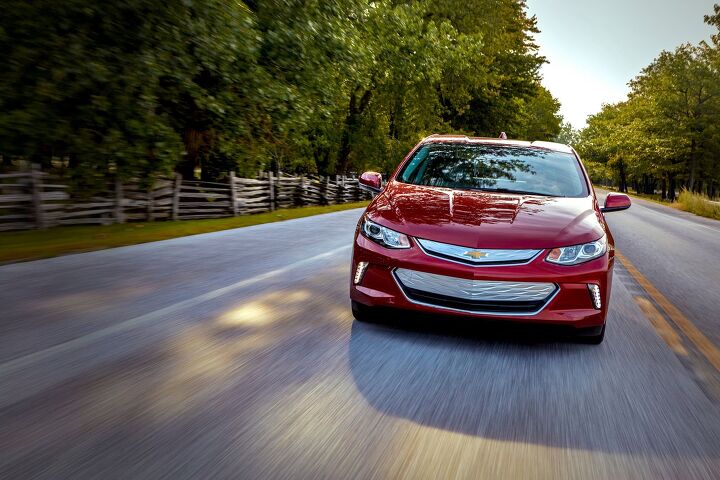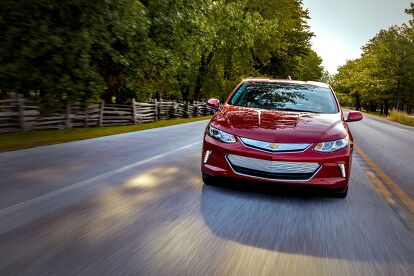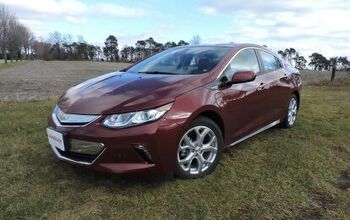2019 Chevrolet Volt Review
Chevrolet introduced the Volt in 2010, an extended-range hybrid whose gasoline generator powered its electric drivetrain, allowing it to drive far beyond any electric-only range.
The Volt could reach 38 miles (61 km) with pure electricity, and ultimately hit 380 miles (612 km) of range in total with the old-school gasoline boost. When it debuted, it seemed complicated. But the antidote to fear is normalcy: most people we know want to drive a normal car, and park it by a normal house, inhabited by other normal people who make normal posts on Facebook. We don’t grow suspicious of technology if it slips into our lives undetected. And with the class of plug-in hybrids like the Volt, the fear of range anxiety — the grandest boogeyman to our electrified future — was all but gone. It helped too that the Volt drove with the bare minimum of future-tech fussiness.
In 2016, the second-generation Volt debuted, upping those electric and total range figures to 53 miles (85 km) and 420 miles (675 km), respectively. Three years later for the 2019 model year, the Volt receives the same set of changes, incremental and sensible, as its fully electric Bolt EV.
New Upgrades
The Volt’s 7.2-inch touchscreen receives an improved infotainment system with new graphics and increased responsiveness. A power driver’s seat is now standard. The Volt gets a new color, Pacific Blue Metallic, and a new interior trim, Jet Black/Porcelain Blue. And the gasoline engine now turns on to add heat to the cabin, instead of exhausting the electric battery pack.
FAST FACTS
| Powertrain: | 1.5L gas engine + two electric motors + 18.4 kWh lithium ion battery |
| System output: | 149 hp, 294 lb-ft of torque |
| EV Range: | 53 miles (85 km) |
| Range + Gas Motor: | 420 miles (675 km) |
| MPGe: | 106 |
| US Price: | Starts at $33,520 |
| CAN Price: | Not yet available |
| : | (Pricing excludes destination and tax credits) |
All well and good. But buried in the press release for the 2019 Volt, is a noteworthy addition: a new 7.2 kW charging system, twice as large as standard, allows the Volt to charge twice as fast, a full charge in two hours instead of four and a half.
The upgraded charger is an option on the base LT trim but standard on Premier. It allows owners of the Volt to take full advantage of opportunity charging. Got just 15 minutes for a grocery run? There, you can charge your Volt in the Whole Foods parking lot, even for just a little bit — and when the opportunity for an overnight charge isn’t available, all of those little charges add up. Through judicious charging disciplines, says Chevrolet, some Volt owners have been able to drive for months on end without a drop of gasoline.
Normal is Nice
The whole ethos of the Volt is how normal it feels: an advanced hybrid that drives like a regular sedan. To that wit, the transition between electric and gasoline range is practically seamless — Volt engineers, Chevrolet told us, made that a priority for the driving experience. Compared to most other gasoline-powered cars, the Volt is remarkably quiet on the freeway; dip into the accelerator and the gasoline engine makes itself heard like a ghost in the basement, and sounding just as unpleasant. Fortunately, it’s sufficiently muffled to barely be noticeable.
Comparisons to the Bolt EV are inevitable. It lacks the instantaneous rocket-launch torque of the electric sibling. But that’s to be expected. The Volt isn’t fast by any stretch of the imagination from a standstill, but accelerate at speed and it’s what Bentley used to say about its cars instead of giving out numbers: it is “sufficient.”
Compared to the Bolt EV it handles comfortably, feeling much lower and more planted. But the suspension is unsettled over pavement cracks, crashing with little refinement.
ALSO SEE: Toyota Prius vs Hyundai Ioniq Hybrid
The interior, in shades of black and white, is a pleasant place to be, with soft-touch surfaces and a low dashboard underneath an expansive windshield. The revised graphics on the gauge cluster are sleek and modern, even showing a lot of depth. Different modes allow you to tweak displays to your heart’s content — which is a relief, because the standard display throws a lot of information at you in the form of bar graphs, changing colors, and digits. Thankfully a simplified view is available. The shifter is of the old-school mechanical variety, which seems incongruous in a modern car where shifting to regenerative L mode is still met with a button and a thunk. We imagine that the Bolt EV’s by-wire shifter will soon make an appearance.
What the Volt does share with the Bolt EV, however, is the Regen On Demand paddle, which allows the car to slow down with the push of a button on regenerative braking only (the brake pedal still applies the Volt’s disc brakes for panic stops). It’s a simple and intuitive way to control your speed.
The navigation screen features two-finger pinching and zooming, which is a joy to use. And the Volt’s Impacts Screen does away with a gamer-like “score,” instead showing how well you’re saving fuel and increasing range in the face of changing weather conditions, route terrain, driving style, and energy-zapping creature comforts.
The Verdict: 2019 Chevrolet Volt Review
In fact, the whole act of fuel-efficient driving is a game unto itself, requiring its own disciplines and skillsets that can only be improved over time. In a technically nerdy manner, it provides its own type of fun. The Volt may drive normally, but if you get behind the wheel of one, you might not drive it in such a normal manner—you might try to aim for that maximum range, accelerating ever-so-gently, or using the regen paddle instead of slamming on the brakes. Hey, it’s your call. Because it’s always good to have options.
Discuss this on our Chevrolet Volt Forum
LOVE IT
- Quiet, comfortable interior
- Handles surprisingly well
- Handsome new display graphics
LEAVE IT
- Suspension could be smoother
More by Blake Z. Rong













































Comments
Join the conversation